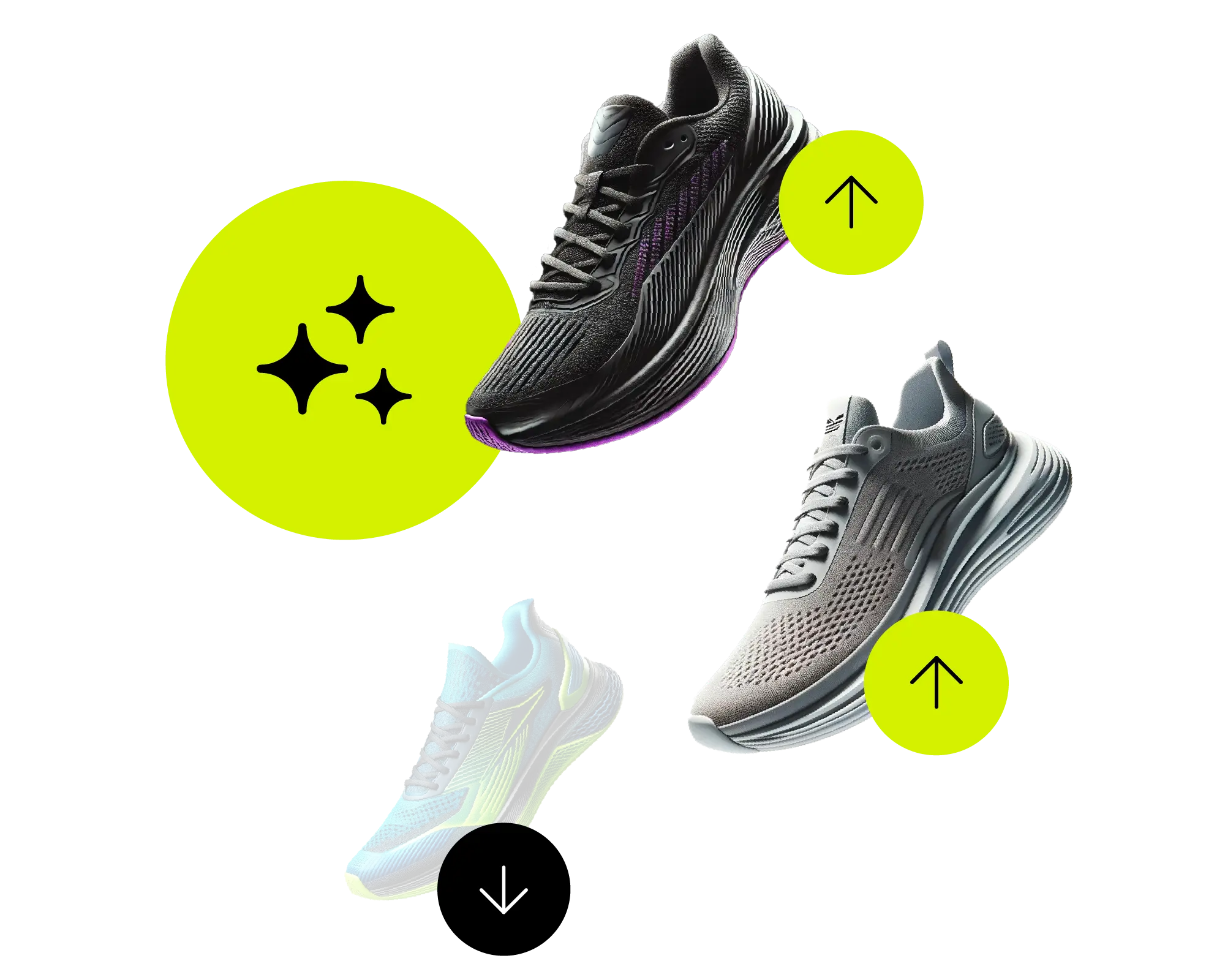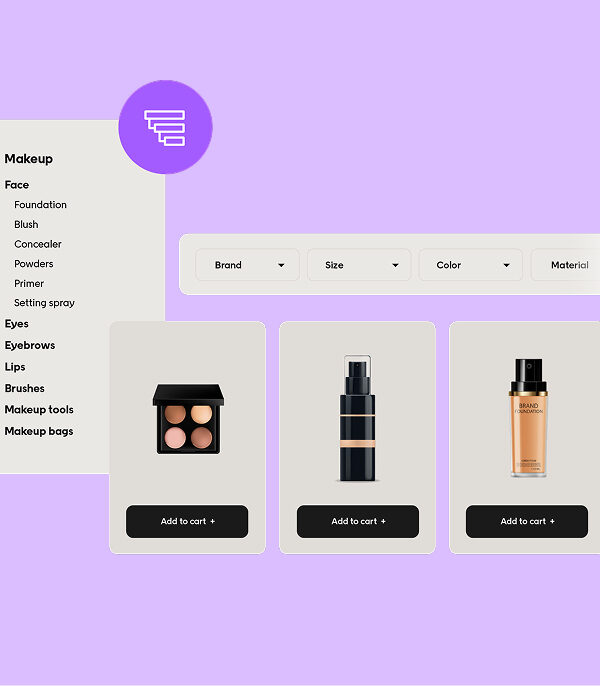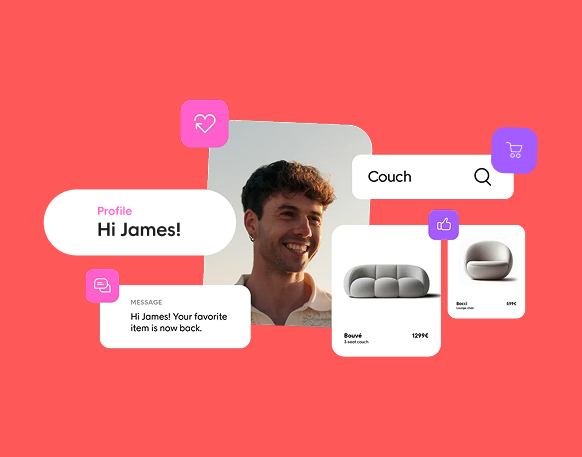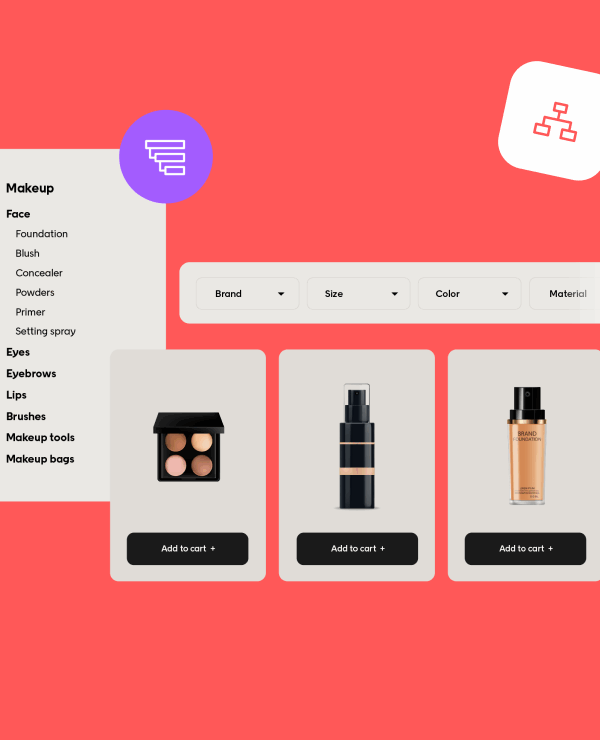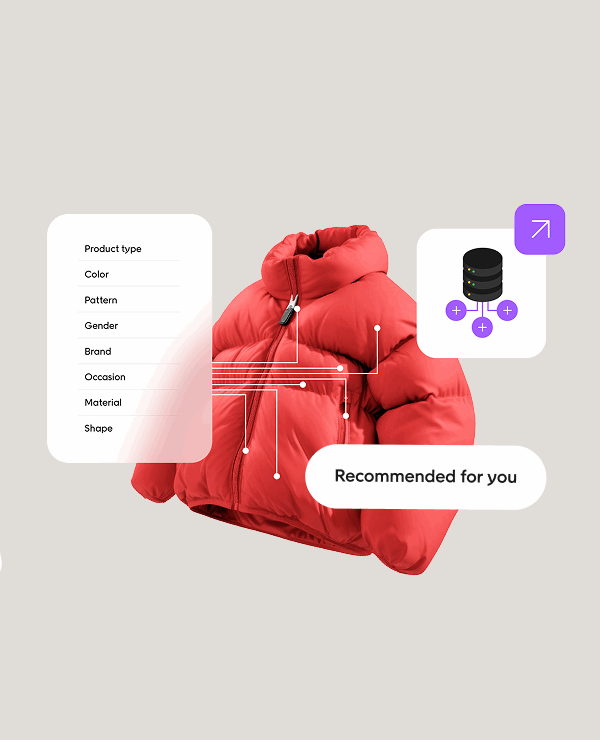Digital merchandising has come a long way from the days of static category pages and basic product filters.
Today, it’s the engine behind modern e-commerce, and it’s shaping how shoppers discover, engage with, and ultimately buy your products.
A strong digital merchandising strategy doesn’t just make your site look good. It guides shoppers based on customer behavior to the right products at the right time, increases conversion rates, and makes your brand feel smart, helpful, and relevant.
We’ll break down 10 strategies to help retailers like you:
- boost product visibility,
- personalize the customer journey,
- and create a seamless shopping experience from first click to checkout.
Whether you’re optimizing a mobile-first experience, fine-tuning product search, or scaling across multiple markets, these tactics will help you stay competitive and grow revenue.
But is your current strategy actually working? Even the most beautiful storefronts can miss the mark if the back-end strategy doesn’t align with how online shoppers behave today.
Signs your current digital merchandising strategy isn’t working
Sometimes, the signs are subtle. Other times, they hit you right in the numbers. If your e-commerce store is struggling to meet expectations, your current strategy might be the problem.
Here are six signs to look out for:
- Low engagement on key pages
If online shoppers are bouncing from category pages or not interacting with featured products, your visual merchandising and product placement may not be capturing attention.
- High cart abandonment rates
Are potential customers adding products but not checking out? That’s often a sign of poor product detail pages, weak social proof, or a clunky checkout experience.
- Stagnant average order value
If your AOV hasn’t increased despite increased traffic, you might be missing cross-sell and upsell opportunities through personalized recommendations or complementary products.
- Inconsistent customer journey
A disconnected experience across mobile apps, desktop, and social commerce platforms makes it hard to build trust and customer loyalty.
- Manual merchandising burnout
If your team is constantly adjusting category pages, homepage layouts, or promotional banners by hand, it’s time to explore AI-powered and data-driven product placement tools.
- You’re flying blind
Without leveraging customer data, user behavior, and tools like Google Analytics, you’re stuck guessing what works and missing the chance to optimize for conversion.
If any of those signs feel familiar, you’re not alone.
Digital merchandising is complex, and even the most established e-commerce brands can miss the mark sometimes.
But there are clear, actionable ways to turn things around. Let’s explore 10 strategies that make that possible.
10 Digital merchandising strategies that truly work
1. Mobile first
Your shoppers aren’t waiting to get home; they’re browsing and buying on their phones. That’s why your digital merchandising strategy must be mobile-first from day one to cater to online customers.
The numbers don’t lie:
According to eMarketer, mobile commerce made up 69.9% of global retail e-commerce sales in 2024. If your store isn’t easy to shop on mobile, you’re losing revenue fast.
Here’s how to optimize for mobile:
- Prioritize speed. Slow-loading mobile pages tank conversions. Compress images, use lightweight code, and test with tools like Google’s Mobile Speed Test.
- Simplify the layout. Use clean, tap-friendly designs with prominent CTAs (Calls to Action) and intuitive filters.
- Use swipeable galleries. Make product images easy to view, zoom, and switch, especially for colour or size variants.
- Add sticky buttons. “Add to cart” or “Buy now” buttons that follow the user down the page are proven to increase conversions.
Have a mobile app?
It can boost engagement, but only if designed well. If you don’t have an app yet, don’t worry. A well‑optimized mobile site still delivers strong results.
Plenty of successful online stores rely on responsive, mobile-friendly experiences to drive engagement and conversions.
Use your analytics tools to find drop-off points in your mobile journey.
- Are shoppers bouncing from category pages?
- Is your search clunky on small screens?
Addressing friction points based on user behavior directly leads to higher sales.

2. Personalized recommendations
Shoppers expect more than a one-size-fits-all experience. They want your store to feel like it understands their preferences: What they’ve browsed, bought, or added to their cart.
That’s where personalized recommendations come in.
Personal recommendations are typically based on:
- The current visitor’s behavior
- What similar customers have purchased
- Items in the cart or previously abandoned
These suggestions make it easier for shoppers to find relevant products, making it more likely they’ll take action.
Personalized online merchandising can also increase Average Order Value (AOV), support upselling and cross-selling, and improve overall product discovery, which helps enhance customer loyalty.
Here’s how to do it well:
- Use browsing and purchase history. Recommend products based on what the shopper has viewed, added to cart, or left behind.
- Try “frequently bought together” and “customers also bought.” These subtle nudges encourage higher-order value without feeling pushy.
- Personalize key pages. Return visitors should see tailored suggestions on the homepage, in search results, and during checkout.
Don’t stop at your website.
Personalisation should carry across email, SMS, and even loyalty touchpoints. A consistent experience builds trust and keeps your brand top of mind.
With Voyado Engage, retailers can automatically generate and deliver personalized product feeds across web, email, and more. And all of this is driven by real-time behavior and purchase data, not guesswork.
3. User-generated content (UGC) and customer reviews
Today’s shoppers trust each other more than they trust marketing copy. That’s why user-generated content (especially customer reviews, ratings, and photos) plays a critical role in online merchandising strategy.
Before making a purchase, people actively seek out real feedback. They want to know:
- Did it fit?
- Was the quality good?
- Would someone like me recommend it?
Here’s how to use UGC to build trust and increase conversions:
- Feature star reviews on product pages. Highlight 4- and 5-star feedback prominently, especially if it addresses common buyer concerns.
- Include customer photos and videos. These help shoppers visualize how the product looks in real life, particularly in categories like fashion, home, and beauty.
- Display review counts. Quantity matters. A product with 50+ reviews can outperform one with five reviews, even if both have high ratings.
- Make UGC visible throughout the journey. Don’t bury reviews in a tab. Use them on product pages, category previews, and even on the homepage.
According to BrightLocal, 88% of consumers trust online reviews as much as personal recommendations.
You can encourage more reviews by automating requests post-purchase or rewarding customers with loyalty points for submitting photos or ratings.
UGC doesn’t just support digital merchandising, it is merchandising. It adds credibility, boosts SEO, and enables buyers to make faster and more confident decisions.

4. Automated merchandising
Manual merchandising just isn’t scalable anymore. With hundreds, or even thousands, of SKUs and constant changes in stock, trends, and customer behavior, you need automation to keep up.
Automated merchandising uses rules, AI, or behavioral data to decide which products to show, where to show them, and when. You won’t need to rely on someone to manually update every collection or banner.
Here’s what automation enables you to do:
- Adapt in real time. When trends shift or new products drop, automation ensures your best-performing or most relevant items get visibility right away.
- Respond to stock levels automatically. Items going out of stock get pushed down or hidden. Newly restocked products can be highlighted instantly.
- Personalize at scale. Instead of showing the same layout to everyone, automation allows for dynamic product listings based on individual user behavior.
Automated merchandising ensures your customers always see the right products at the right time without overwhelming your team.
Voyado Elevate enables fully automated product placement across your site.
It uses customer behavior and product performance data to highlight what’s trending, demote what’s underperforming, and keep merchandising fresh across categories, search results, and landing pages.
Whether you’re dealing with seasonal campaigns or shifting demand, automation helps your strategy stay agile, keeping shoppers engaged.
5. Optimize your SEO
Search still matters, especially at the beginning of the buying journey. If your products or content don’t show up, you’re already out of the running.
That’s why SEO should be baked into your strategy, not treated as a separate initiative.
Here’s how to make it work:
- Create high-quality, relevant content. Blog posts, guides, FAQs, and landing pages that speak directly to your customers’ intent can bring in long-tail traffic.
- Target the right keywords. Focus on terms your ideal audience is actually searching for, not just brand or product names.
- Optimize your product pages. Include descriptive titles, meta descriptions, alt text, and internal links to make sure every item is discoverable.
Having strong content across your site is one of the most effective ways to increase visibility and improve your Google search ranking.
Search engines reward relevant, high-quality content, so make sure every page is optimized for clarity and intent.
We recommend using tools like Google Search Console or Ahrefs to see what your customers are already searching for and identify new opportunities to rank.
6. Be unique, run A/B tests
Sameness doesn’t sell. If your store looks and behaves just like everyone else’s in terms of digital marketing, there’s little reason for a shopper to stick around, let alone convert.
That’s why experimentation matters.
A/B testing lets you trial two versions of the same page, each with slight differences in layout, copy, or functionality. Real users see one version or the other, and you can measure which performs better based on actual behavior.
Here’s what to test:
- CTA buttons: Wording, colour, or placement
- Homepage banners: Static vs. animated, different promotions or messaging
- Product page layouts: Image size, description order, social proof placement
Even small design tweaks can lead to meaningful improvements in engagement, time on site, and conversion rates.
Be sure to start with one element at a time. You’ll get cleaner results and a clearer sense of what’s actually influencing behavior.
By testing consistently on personalized recommendations, you’re learning exactly what resonates with your audience instead of guessing. And that kind of insight is gold for any strategy.
7. Get your customers what they are searching for
As soon as a visitor lands on your site, the goal is clear: help them quickly find exactly what they’re looking for.
To do that well, you need to understand their intent, behavior, and preferences. That’s where data comes in.
By tracking everything from site search and navigation patterns to product recommendations, you can start to build a picture of what customers respond to (and what they don’t).
AI and machine learning take this even further.
They help you deliver consistent, dynamic product assortments tailored to each shopper’s behavior, in real time.
So whether someone is a first-time visitor or a long-time customer, they’ll see items that make sense for them, driven by the same intelligent engine across every touchpoint.
Result: A smoother user experience. Faster product discovery. Higher engagement.
8. Visual merchandising
Online shoppers can’t touch or try your products, so visuals do the heavy lifting.
Make sure your product pages include:
- High-quality images from multiple angles
- Badges to differentiate what’s on sale or new
- Zoom functionality for close-up detail
- A separate image for each colour variant
- Videos showing the product in use
- Ratings and reviews front and centre
- Clear product descriptions and specifications
These elements build confidence and reduce friction at the point of purchase.
Visual merchandising is about empowering customers to say “yes” faster.
9. Video content
Video gives your products dimension and your brand a personality. It helps shoppers imagine how something works, fits, or feels in a way that photos and descriptions alone often can’t.
When used well, video builds trust, reduces hesitation, and encourages faster decisions.
Here’s how to use video effectively in your digital merchandising:
- Show products in use. Whether it’s how a coat moves, how a device functions, or how a skincare product is applied. Context makes a difference!
- Answer common questions. Walk through key features or demonstrate details that customers typically want to know before they buy.
- Keep it short and clear. Aim for clarity over flash. Clean visuals, good lighting, and steady audio matter more than fancy transitions.
You don’t need a film studio to get started. Even simple, well-shot videos can enhance product pages, boost engagement, and support faster purchase decisions by giving customers the clarity they need.

10. The perfect product page
Your product page is the final step before conversion, so it needs to work hard. It’s not just a place to list features. It’s where you build trust, answer questions, and remove hesitation.
A perfect product page includes various aspects of product merchandising :
- Clear, compelling copy. Start with a short, scannable overview, followed by a more detailed description for those who want to dig deeper.
- High-quality visuals. Use crisp product photos from multiple angles, lifestyle shots, and videos that show the product in action.
- Customer reviews and ratings. Social proof can often be the final nudge a shopper needs to convert.
- Smart recommendations. Help customers explore related or complementary products to increase AOV and support discovery.
But great content alone isn’t enough. Personalisation, filtering, and AI-powered merchandising all play a role in building perfect product pages. That means pages that convert because they are relevant, informative, and easy to navigate.
Think of your product page as a digital salesperson. Every element, from copy to content placement, should guide the customer toward a confident decision.
Make your store work smarter, not harder
You’ve seen the tactics. You’ve seen the tools. Now it’s time to take action.
A strong digital merchandising strategy is about alignment, where search, navigation, recommendations, and product pages all work together to create a seamless, personalized experience.
Here’s how to move forward:
- Pick 2–3 focus areas.
Start with what feels most urgent, maybe your site search isn’t converting, or product pages aren’t doing their job. - Use what you already have.
Your customer data holds the answers. Lean on AI-powered tools and insights to personalize, optimize, and test. - Think like a shopper.
Ask: Does this journey feel fast? Relevant? Easy? If not, adjust.
A seamless customer experience, where every interaction feels intuitive and rewarding, is your strongest asset.
And the next boost in conversions? It’s already in your data; you just have to unlock it.
FAQs
What’s the difference between traditional and digital merchandising?
Traditional merchandising focuses on physical store tactics like shelf displays and signage. Digital merchandising, by contrast, is about how you present products across your e-commerce store. This is done using search, filtering, personalized recommendations, and dynamic content to guide the online shopping journey and drive sales.
How do I know which digital merchandising tactics are working?
Use tools like Google Analytics to track how website visitors interact with your content. Metrics like average order value (AOV), bounce rate, and product views help you understand user behavior and preferences. Layer in A/B testing, heatmaps, and customer data to refine your strategy and meet evolving customer expectations.
Do I need a dedicated team to build a digital merchandising strategy?
Not necessarily. Many AI-powered tools and platforms now support data-driven product placement and automation, helping e-commerce brands scale without needing a large team. The key is finding tech that aligns with your goals, whether that’s retaining customers, increasing visibility on category pages, or optimizing for seasonal trends.
How important is personalisation in digital merchandising?
It’s essential. Personalisation helps you deliver relevant products based on purchase history, search queries, and user behavior. Whether through natural language processing in site search or social proof, such as reviews and user-generated content (UGC), personalized digital merchandising drives customer satisfaction and creates a more compelling brand experience.
What makes a product page “perfect”?
The best product pages combine strong content with smart merchandising. That means high-quality images, concise and persuasive copy, user-generated content, complementary products, and mobile-friendly design. It’s all about guiding the customer journey, from first click to confident purchase, while reflecting your brand identity and strategic product placement goals.

